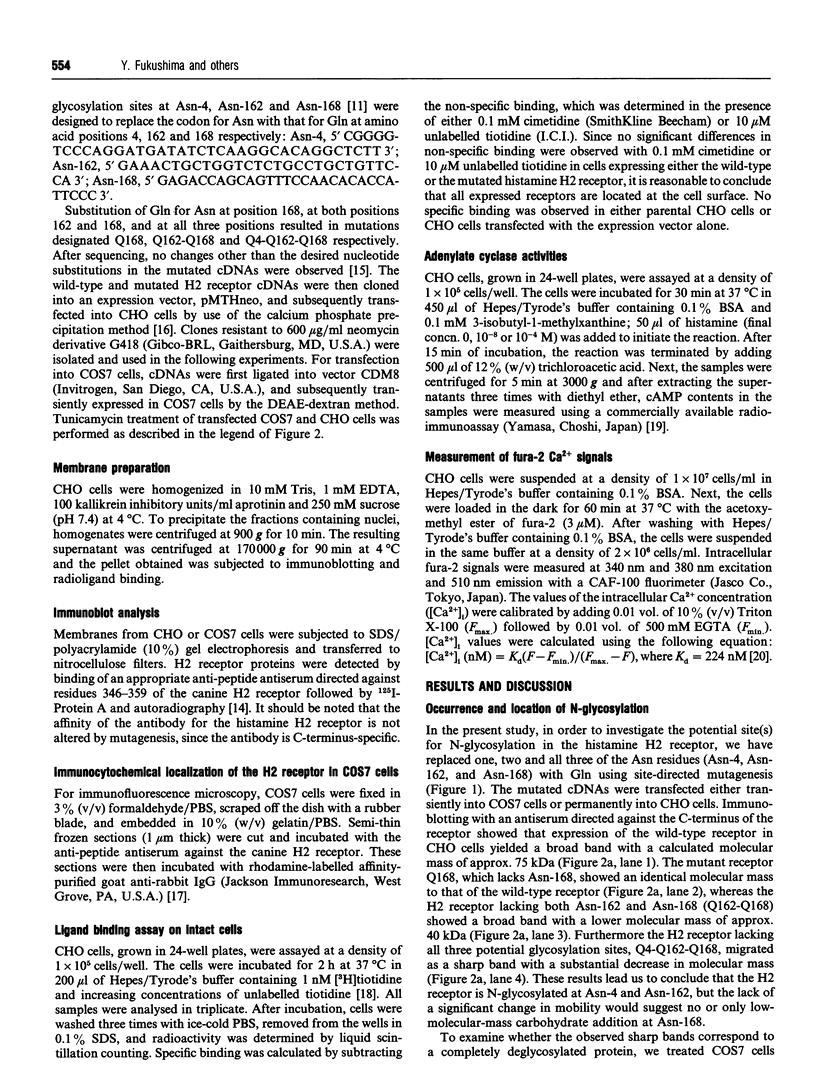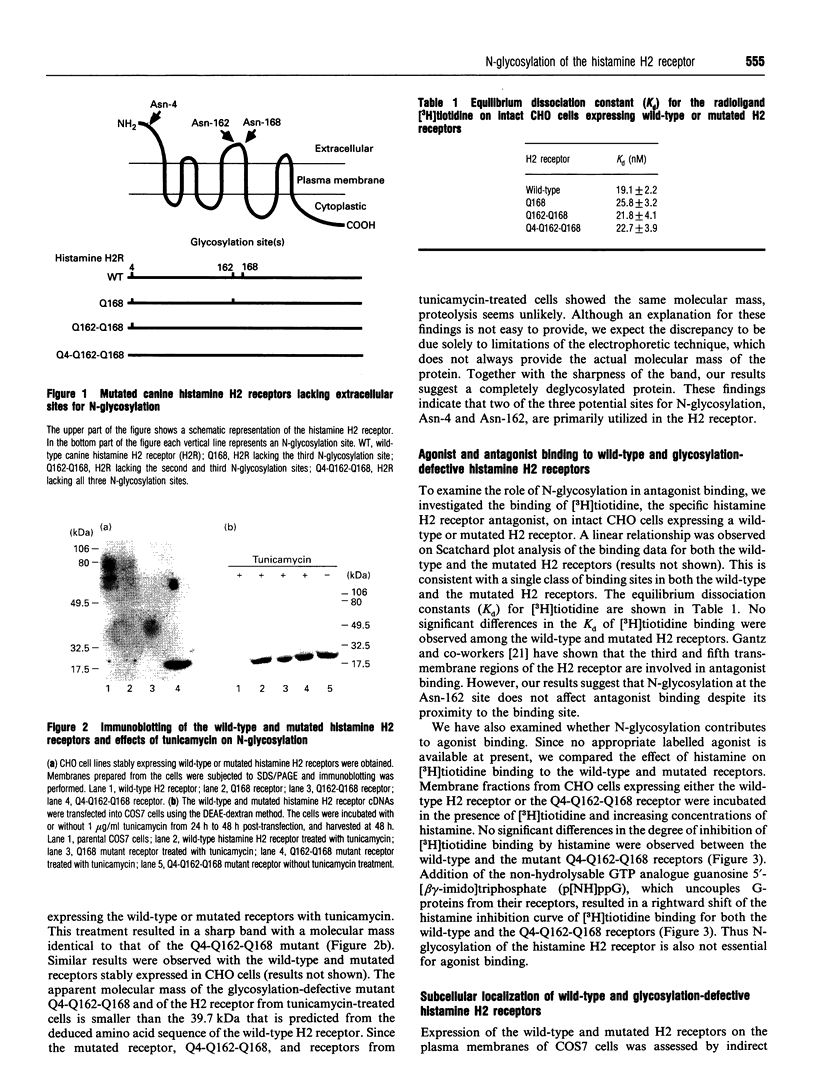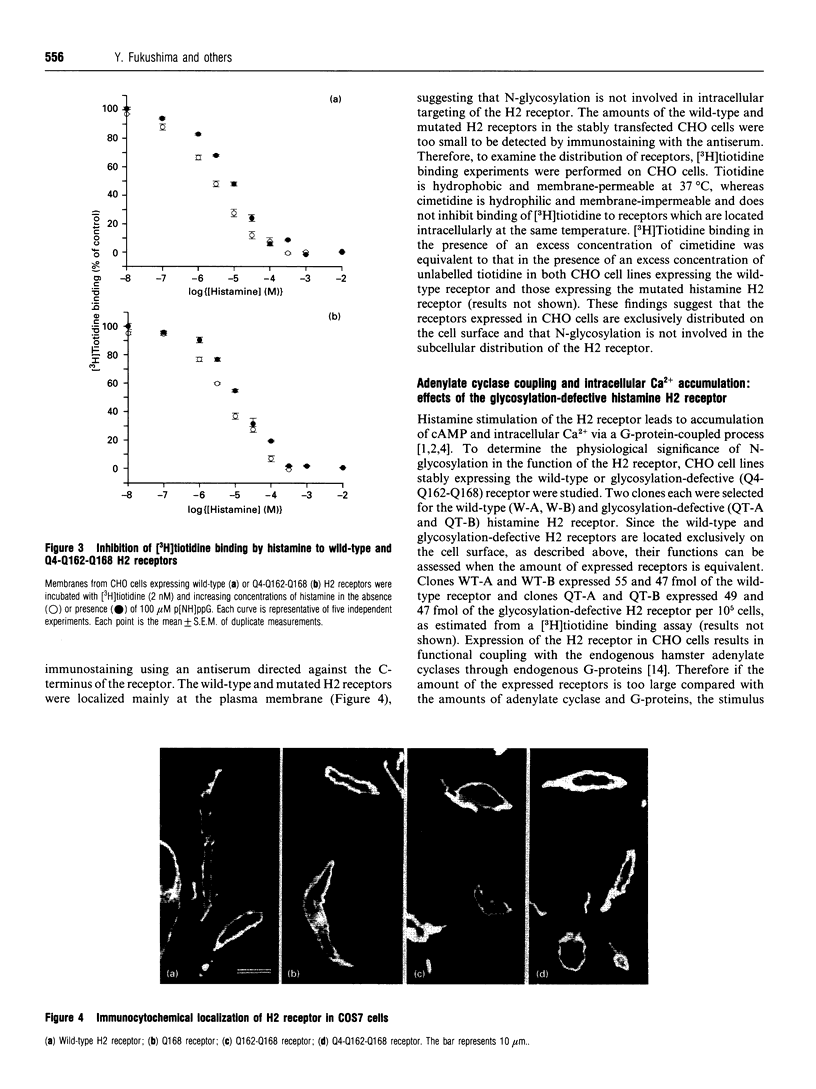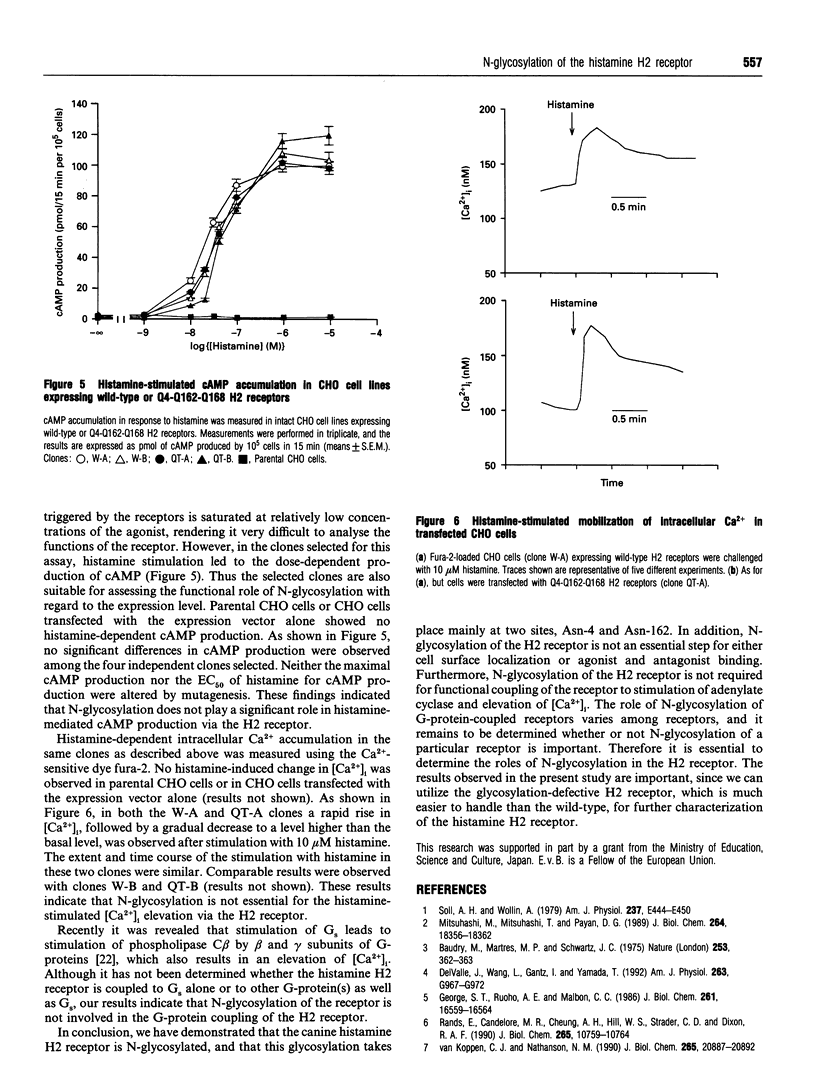Abstract
G-protein-coupled receptors generally share a similar structure containing seven membrane-spanning domains and extracellular site(s) for N-glycosylation. The histamine H2 receptor is a member of the family of G-protein-coupled receptors, and has three extracellular potential sites for N-glycosylation (Asn-4, Asn-162 and Asn-168). To date, however, no information has been presented regarding N-glycosylation of the H2 receptor. To investigate the presence, location and functional roles of N-glycosylation of the H2 receptor, site-directed mutagenesis was performed to eliminate the potential site(s) for N-glycosylation singly and collectively. The wild-type and mutated H2 receptors were expressed stably in Chinese hamster ovary (CHO) cells or transiently in COS7 cells. Immunoblotting of the wild-type and mutated H2 receptors with an antiserum directed against the C-terminus of the H2 receptor showed that mutation at Asn-162, but not at Asn-168, resulted in a substantial decrease in the molecular mass. A mutation at Asn-4 led to a further decrease in the molecular mass. Tunicamycin treatment of the transfected cells yielded a sharp band with a molecular mass identical to that of the mutant devoid of all three potential sites for N-glycosylation. These findings indicate that the H2 receptor is N-glycosylated, and that N-glycosylation takes place mainly at two sites, Asn-4 and Asn-162. Neither the affinity for tiotidine nor that for histamine was affected by the mutagenesis. Immunocytochemistry and tiotidine binding showed that the mutated receptors were exclusively distributed on the cell surface in a fashion similar to that of the wild-type. In addition, the glycosylation-defective receptor was capable of activating adenylate cyclase and elevating the intracellular Ca2+ concentration in response to histamine in stable CHO cell lines. Thus N-glycosylation of the H2 receptor is not required for cell surface localization, ligand binding or functional coupling to G-protein(s).
Full text
PDF





Images in this article
Selected References
These references are in PubMed. This may not be the complete list of references from this article.
- Allgeier A., Offermanns S., Van Sande J., Spicher K., Schultz G., Dumont J. E. The human thyrotropin receptor activates G-proteins Gs and Gq/11. J Biol Chem. 1994 May 13;269(19):13733–13735. [PubMed] [Google Scholar]
- Asano T., Shibasaki Y., Ohno S., Taira H., Lin J. L., Kasuga M., Kanazawa Y., Akanuma Y., Takaku F., Oka Y. Rabbit brain glucose transporter responds to insulin when expressed in insulin-sensitive Chinese hamster ovary cells. J Biol Chem. 1989 Feb 25;264(6):3416–3420. [PubMed] [Google Scholar]
- Asano T., Takata K., Katagiri H., Tsukuda K., Lin J. L., Ishihara H., Inukai K., Hirano H., Yazaki Y., Oka Y. Domains responsible for the differential targeting of glucose transporter isoforms. J Biol Chem. 1992 Sep 25;267(27):19636–19641. [PubMed] [Google Scholar]
- Baudry M., Martres M. P., Schwartz J. C. H1 and H2 receptors in the histamine-induced accumulation of cyclic AMP in guinea pig brain slices. Nature. 1975 Jan 31;253(5490):362–364. doi: 10.1038/253362a0. [DOI] [PubMed] [Google Scholar]
- Chochola J., Fabre C., Bellan C., Luis J., Bourgerie S., Abadie B., Champion S., Marvaldi J., el Battari A. Structural and functional analysis of the human vasoactive intestinal peptide receptor glycosylation. Alteration of receptor function by wheat germ agglutinin. J Biol Chem. 1993 Feb 5;268(4):2312–2318. [PubMed] [Google Scholar]
- Delvalle J., Wang L., Gantz I., Yamada T. Characterization of H2 histamine receptor: linkage to both adenylate cyclase and [Ca2+]i signaling systems. Am J Physiol. 1992 Dec;263(6 Pt 1):G967–G972. doi: 10.1152/ajpgi.1992.263.6.G967. [DOI] [PubMed] [Google Scholar]
- Fukushima Y., Oka Y., Katagiri H., Saitoh T., Asano T., Ishihara H., Matsuhashi N., Kodama T., Yazaki Y., Sugano K. Desensitization of canine histamine H2 receptor expressed in Chinese hamster ovary cells. Biochem Biophys Res Commun. 1993 Feb 15;190(3):1149–1155. doi: 10.1006/bbrc.1993.1170. [DOI] [PubMed] [Google Scholar]
- Gajtkowski G. A., Norris D. B., Rising T. J., Wood T. P. Specific binding of 3H-tiotidine to histamine H2 receptors in guinea pig cerebral cortex. Nature. 1983 Jul 7;304(5921):65–67. doi: 10.1038/304065a0. [DOI] [PubMed] [Google Scholar]
- Gantz I., DelValle J., Wang L. D., Tashiro T., Munzert G., Guo Y. J., Konda Y., Yamada T. Molecular basis for the interaction of histamine with the histamine H2 receptor. J Biol Chem. 1992 Oct 15;267(29):20840–20843. [PubMed] [Google Scholar]
- Gantz I., Munzert G., Tashiro T., Schäffer M., Wang L., DelValle J., Yamada T. Molecular cloning of the human histamine H2 receptor. Biochem Biophys Res Commun. 1991 Aug 15;178(3):1386–1392. doi: 10.1016/0006-291x(91)91047-g. [DOI] [PubMed] [Google Scholar]
- Gantz I., Schäffer M., DelValle J., Logsdon C., Campbell V., Uhler M., Yamada T. Molecular cloning of a gene encoding the histamine H2 receptor. Proc Natl Acad Sci U S A. 1991 Jan 15;88(2):429–433. doi: 10.1073/pnas.88.2.429. [DOI] [PMC free article] [PubMed] [Google Scholar]
- George S. T., Ruoho A. E., Malbon C. C. N-glycosylation in expression and function of beta-adrenergic receptors. J Biol Chem. 1986 Dec 15;261(35):16559–16564. [PubMed] [Google Scholar]
- Grynkiewicz G., Poenie M., Tsien R. Y. A new generation of Ca2+ indicators with greatly improved fluorescence properties. J Biol Chem. 1985 Mar 25;260(6):3440–3450. [PubMed] [Google Scholar]
- Honma M., Satoh T., Takezawa J., Ui M. An ultrasensitive method for the simultaneous determination of cyclic AMP and cyclic GMP in small-volume samples from blood and tissue. Biochem Med. 1977 Dec;18(3):257–273. doi: 10.1016/0006-2944(77)90060-6. [DOI] [PubMed] [Google Scholar]
- Jans D. A., Jans P., Luzius H., Fahrenholz F. N-glycosylation plays a role in biosynthesis and internalization of the adenylate cyclase stimulating vasopressin V2-receptor of LLC-PK1 renal epithelial cells: an effect of concanavalin A on binding and expression. Arch Biochem Biophys. 1992 Apr;294(1):64–69. doi: 10.1016/0003-9861(92)90137-l. [DOI] [PubMed] [Google Scholar]
- Liu X., Davis D., Segaloff D. L. Disruption of potential sites for N-linked glycosylation does not impair hormone binding to the lutropin/choriogonadotropin receptor if Asn-173 is left intact. J Biol Chem. 1993 Jan 25;268(3):1513–1516. [PubMed] [Google Scholar]
- Mitsuhashi M., Mitsuhashi T., Payan D. G. Multiple signaling pathways of histamine H2 receptors. Identification of an H2 receptor-dependent Ca2+ mobilization pathway in human HL-60 promyelocytic leukemia cells. J Biol Chem. 1989 Nov 5;264(31):18356–18362. [PubMed] [Google Scholar]
- Rands E., Candelore M. R., Cheung A. H., Hill W. S., Strader C. D., Dixon R. A. Mutational analysis of beta-adrenergic receptor glycosylation. J Biol Chem. 1990 Jun 25;265(18):10759–10764. [PubMed] [Google Scholar]
- Ruat M., Traiffort E., Arrang J. M., Leurs R., Schwartz J. C. Cloning and tissue expression of a rat histamine H2-receptor gene. Biochem Biophys Res Commun. 1991 Sep 30;179(3):1470–1478. doi: 10.1016/0006-291x(91)91738-x. [DOI] [PubMed] [Google Scholar]
- Sanger F., Nicklen S., Coulson A. R. DNA sequencing with chain-terminating inhibitors. Proc Natl Acad Sci U S A. 1977 Dec;74(12):5463–5467. doi: 10.1073/pnas.74.12.5463. [DOI] [PMC free article] [PubMed] [Google Scholar]
- Soll A. H., Wollin A. Histamine and cyclic AMP in isolated canine parietal cells. Am J Physiol. 1979 Nov;237(5):E444–E450. doi: 10.1152/ajpendo.1979.237.5.E444. [DOI] [PubMed] [Google Scholar]
- van Koppen C. J., Nathanson N. M. Site-directed mutagenesis of the m2 muscarinic acetylcholine receptor. Analysis of the role of N-glycosylation in receptor expression and function. J Biol Chem. 1990 Dec 5;265(34):20887–20892. [PubMed] [Google Scholar]




